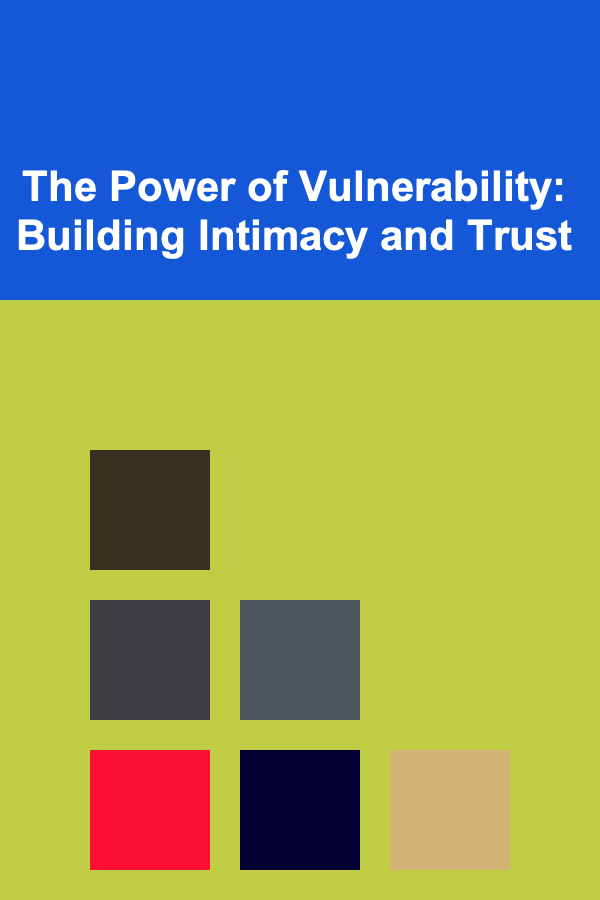
The Power of Vulnerability: Building Intimacy and Trust
ebook include PDF & Audio bundle (Micro Guide)
$12.99$6.99
Limited Time Offer! Order within the next:

Vulnerability is often seen as a weakness in a world that emphasizes strength, self-sufficiency, and resilience. However, the reality is far more nuanced. Vulnerability is the cornerstone of authentic relationships, the foundation of deep trust, and the catalyst for true intimacy. It is only through vulnerability that we can truly connect with others on a meaningful level, create bonds that withstand time and adversity, and heal emotional wounds that might otherwise remain hidden.
In this article, we will explore the power of vulnerability, its significance in building intimacy and trust, and how embracing vulnerability can lead to healthier, more fulfilling relationships. We will break down how vulnerability impacts our emotional well-being, the challenges of allowing ourselves to be vulnerable, and practical steps for becoming more open and authentic in our interactions.
Defining Vulnerability
Vulnerability can be defined as the willingness to expose one's true self---our emotions, thoughts, fears, desires, and weaknesses---to others, without the certainty of acceptance or protection. It is the act of opening up and allowing oneself to be seen in an authentic, raw, and unfiltered way. Vulnerability requires courage because it involves a risk: the possibility of rejection, judgment, or even betrayal.
However, despite the risks, vulnerability is at the heart of what makes us human. It is through vulnerability that we build the foundation for emotional connections. It allows us to be real with others and with ourselves, fostering an environment where authenticity can flourish.
1.1 The Role of Vulnerability in Emotional Connection
Vulnerability is not only about sharing our weaknesses; it's also about sharing our hopes, dreams, and desires. It involves expressing our innermost thoughts, revealing our true feelings, and trusting that others will listen and accept us for who we are. It's this openness that creates emotional intimacy---a deep, meaningful connection with another person that transcends superficial interactions.
When we allow ourselves to be vulnerable, we invite others to do the same. Vulnerability is contagious. By being authentic and open, we create a safe space where others feel empowered to express their own true selves, leading to deeper and more intimate relationships.
Vulnerability and Trust: The Symbiotic Relationship
Trust is the bedrock of any healthy relationship, whether it's romantic, familial, or platonic. But trust is not built overnight---it is nurtured through consistent, honest, and vulnerable communication. Vulnerability and trust are deeply interconnected; one cannot exist without the other.
2.1 Building Trust Through Vulnerability
Vulnerability is the gateway to trust. When we allow ourselves to be vulnerable with others, we show that we trust them with our most authentic selves. This act of trust often encourages others to respond in kind. It signals to them that we are open to emotional closeness and that we value the relationship enough to risk being seen as imperfect.
However, building trust through vulnerability is not an immediate process. It takes time, patience, and consistency. Trust is earned through repeated acts of vulnerability, where both parties demonstrate reliability, understanding, and empathy. The more we allow ourselves to be vulnerable and share our true selves, the more likely others will do the same, creating a mutual trust that strengthens the bond.
2.2 The Cycle of Vulnerability and Trust
The cycle of vulnerability and trust is one of mutual reinforcement. The more vulnerable we are, the more trust we build. As trust deepens, we feel safer to open up further, which in turn deepens the trust. This cycle creates a positive feedback loop that strengthens the relationship and fosters deeper emotional connection.
2.3 The Fear of Vulnerability
Despite the importance of vulnerability in building trust, many people struggle with it. Fear of rejection, judgment, or betrayal often holds individuals back from being open with others. These fears are understandable, given that vulnerability exposes us to potential hurt. However, avoiding vulnerability out of fear only inhibits the development of deep, meaningful relationships.
Overcoming the fear of vulnerability requires self-awareness and self-compassion. It involves acknowledging that vulnerability is a strength, not a weakness. By recognizing that taking emotional risks is essential for building authentic relationships, we can gradually break down the walls we've constructed around ourselves and allow others to see us as we truly are.
The Impact of Vulnerability on Intimacy
Intimacy is the deep emotional connection that exists between two people. It goes beyond physical attraction or shared experiences---it is the bond that forms when two people trust each other enough to expose their inner worlds. Intimacy is built through vulnerability, as it is only through open and honest sharing that true closeness can be achieved.
3.1 Emotional Intimacy
Emotional intimacy is cultivated when we share our deepest emotions, struggles, and joys with another person. It involves revealing our fears, our dreams, our past experiences, and our vulnerabilities. Emotional intimacy requires both parties to be vulnerable with one another, providing a foundation of trust that allows them to support and comfort each other during difficult times.
When emotional intimacy exists, both people feel safe enough to be their true selves. They can express their feelings without fear of judgment, knowing that their partner will accept them for who they are. This mutual vulnerability creates a space where both individuals feel understood, valued, and cared for.
3.2 Physical Intimacy
While emotional intimacy is the primary driver of deep connection, physical intimacy often follows. The connection created by emotional vulnerability makes physical closeness more meaningful. When two people are emotionally intimate, physical intimacy is not just about physical pleasure---it becomes an expression of the bond they share.
Vulnerability in physical intimacy means being open about desires, boundaries, and expectations. It involves being honest about what feels good, what doesn't, and what both partners need to feel safe and connected. This level of openness creates a deeper, more fulfilling physical relationship.
3.3 Vulnerability and Self-Awareness
Self-awareness is key to vulnerability. In order to be vulnerable with others, we first need to be vulnerable with ourselves. This means being honest about our emotions, needs, and desires. It requires introspection and an understanding of our own fears and limitations.
When we are self-aware, we can communicate our needs and boundaries more effectively, allowing others to better understand us. This, in turn, leads to greater emotional and physical intimacy. By being honest with ourselves, we create the space for deeper connection with others.
The Challenges of Vulnerability
Despite the power of vulnerability in creating deep, meaningful relationships, it is not always easy to embrace. Our society often views vulnerability as a weakness, encouraging people to hide their true selves in favor of presenting a strong, perfect image. This societal pressure can make it difficult to embrace vulnerability, even though it is essential for building trust and intimacy.
4.1 Fear of Rejection
One of the most significant barriers to vulnerability is the fear of rejection. We fear that if we open ourselves up, we will be judged or abandoned by those we care about. This fear can lead to emotional walls that prevent us from connecting with others on a deeper level.
While rejection is always a possibility, the act of vulnerability itself is a powerful statement of courage. Even if we are rejected, we can take solace in knowing that we gave others the opportunity to see the real us. Moreover, vulnerability can serve as a filter, allowing us to connect with people who appreciate us for who we truly are.
4.2 The Fear of Judgment
Along with the fear of rejection comes the fear of judgment. We worry that others will see us as weak, flawed, or unworthy if we expose our vulnerabilities. However, true connection comes from being authentic---not from presenting a perfect, curated version of ourselves.
By embracing vulnerability, we challenge the societal norms that encourage perfectionism and surface-level connections. We model authenticity for others and create the space for them to do the same. This not only deepens our relationships but also fosters an environment where others feel safe to be their true selves.
4.3 The Fear of Betrayal
The fear of betrayal is another significant obstacle to vulnerability. When we open ourselves up to others, we risk having our trust broken. Past experiences of betrayal can make it difficult to embrace vulnerability, but it is important to remember that vulnerability is an act of self-respect.
By allowing ourselves to be vulnerable, we take the first step toward healing. We learn to trust again, not by closing ourselves off, but by taking small steps to build trust in healthy, supportive relationships.
Practical Steps to Embrace Vulnerability
While embracing vulnerability can be difficult, it is a skill that can be developed over time. Here are some practical steps to help you embrace vulnerability and build deeper, more meaningful connections:
5.1 Start Small
You don't need to expose your deepest fears and desires all at once. Begin by sharing small, personal details with trusted friends or loved ones. As you gain confidence in your ability to be vulnerable, you can gradually open up about more significant aspects of yourself.
5.2 Practice Active Listening
Vulnerability is a two-way street. To encourage others to open up, practice active listening. Show empathy, offer validation, and create a safe space for others to share their experiences. This will help build trust and encourage reciprocal vulnerability.
5.3 Be Compassionate with Yourself
Vulnerability requires self-compassion. Be patient with yourself as you navigate the process of opening up. Acknowledge that it is okay to feel afraid or uncertain. Practice self-care and take time to reflect on your experiences as you move forward.
5.4 Seek Supportive Relationships
Surround yourself with people who appreciate your vulnerability and value authenticity. Seek relationships that are built on mutual trust, respect, and emotional openness. These relationships will provide the foundation for deeper intimacy and connection.
Conclusion
Vulnerability is not a weakness---it is a strength. It is through vulnerability that we build trust, create intimacy, and foster deep, meaningful connections with others. By embracing vulnerability, we open ourselves up to the possibility of true emotional closeness, offering the opportunity for healing, growth, and mutual support. As we learn to be more vulnerable, we not only strengthen our relationships but also create a more authentic and fulfilling life.

How to Choose the Right Contractors for Your Home Renovation
Read More
How to Choose the Right Platform for Your Self Media Brand
Read More
How to Store Essential Oils Safely and Effectively
Read More
How to Turn Your Artistic Hobby into a Source of Income
Read More
Understanding the Benefits of Index Funds for FIRE
Read More
How to Build a DIY Bioluminescence Kit
Read MoreOther Products

How to Choose the Right Contractors for Your Home Renovation
Read More
How to Choose the Right Platform for Your Self Media Brand
Read More
How to Store Essential Oils Safely and Effectively
Read More
How to Turn Your Artistic Hobby into a Source of Income
Read More
Understanding the Benefits of Index Funds for FIRE
Read More